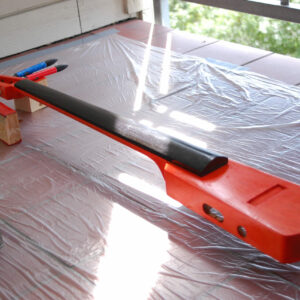Varnishing complex shapes, each surface individually, or all in one?
Hi
I’m a hobbyist who have been struggling to varnish a complex object, it is a musical instrument. I had figured I had to varnish it all in one go, so there are no visible transitions. It needs varnish on the upside and the underside. I had figured out an elaborate way to do that, but the result was not so great. There were sags and unevennesses. I reckon it doesn’t matter, as it’s only the first coat, but I’d like some advice on how to go on for the next coat.
I had made some test pieces, and they came out great, but they were all horizontal surfaces.
There are semi-sharp edges between different surfaces, so it may be that I should varnish one surface at a time instead? Then I can have them all horizontal. It will take longer, of course, but if it can be done with great results, maybe that’s the way. What do you think?
See the picture for the object.
EDIT: The type of varnish is Polyurethane, clear gloss.
















Replies
You don't say, but it sounds like you are applying by hand? Also, don't know what the "varnish" is. To wit. When working in luthiers shop years ago-all instruments were sprayed in one go so as to eliminate the problems you're talking about among other things. The only time hand finishing was done was french polishing to repair shellac finishes. If you dont have access or $$ for spray gear - I would suggest using a rattle can and spray it on. It's a small instrument and it should be effective.Sand down blemishes from first attempt as best you can-not sure how much you have between that and your color. Hang it vertically from the pegbox when doing so.
Thank you. You are right, I was applying by hand, with a brush. I will get a spray can and try it instead!
Good luck with it - looks like a "Steinberger Tenor/Ukulele". Also, we used a spray booth - but you can make something either with zip walls and also mist the floor with H20 night before spraying to keep the dust manageable.
It's going to be an electric cello. It's about 1 meter long. I will use it outside, and protect my walls with a plastic sheet, that'll do. I've already brought the spray, but will have to wait for the first coat to dry.
Great
Go with the spray can, but be careful with the instructions for temp and humidity on the can. I sprayed a Uke last fall and got quite a bit of blooming on the first go. That's when I learned about the effects of humidity when using a rattle can. (I used lacquer)
Look for a can with a fan-shaped spray pattern instead of round, it's far easier to get even coats. Deft makes cans of lacquer with a great fan pattern, not sure about the poly.
Thank you. I live in Oslo, Norway, and have never heard about or seen Deft in any hardware store around here. I have gotten something called Quick Bengalack Universal, which is a staple brand around here, and I assume midrange quality. The type is stated as "Alkyd". I don't know much about types, but I assume/hope it will work over the polyurethane coat. It says nothing about spray pattern. The polyurethane was Liberon Bistrot, which is a top range UK product.
I tested it out on scrap pieces yesterday, and struggled to find that sweet spot between dew-on-window and too much causing sagging/running. However I did it outside and the wind started blowing so I couldn't practice much. I have to try it inside today, but then I have to set it up properly so I don't get varnish all over my home. I have no work room big enough for it.
Any tips on how to get a good result is greatly appreciated.
I spray semi-indoors... in the mouth of a garage. I wait for a perfect day, sometimes for a while. Spraying in the house or shop is a non-starter because of the stink. I hang the target from a stiff wire so I can move around it.
I don't know if you can find something in Norway with a fan spray pattern, but it makes a massive difference and you'll be happy if you do. Good luck!
That is some of the best advice I didn't read until it was too late! Let's just say that all of my doors and windows are now open, and there's a fair chance that cello will be sleeping on the veranda tonight... :D :D :D
Luckily I had a gas mask on me. The varnish is supposed to dry within an hour, so hopefully the fumes wear off pretty soon.
Also, an inexpensive air brush would work great. It would represent a bit more up front expense and you have setup and cleanup to do, but once you have it, it would be available for future projects. Also, an air brush allows you to adjust the spray which helps with hard to get to places.
In the world of very expensive hand built instruments it's not uncommon for a luthier to charge a premium for their varnished version. That premium can add as much as $5000 to what might be otherwise an identical instrument with a sprayed nitrocellulous finish. Most seem to complete an instrument in the white and then finish.
The nuttiest bunch of instrument builders going are mandolin builders. I would suggest that you take this question to Mandolin Cafe and ask the same question.
This forum post is now archived. Commenting has been disabled